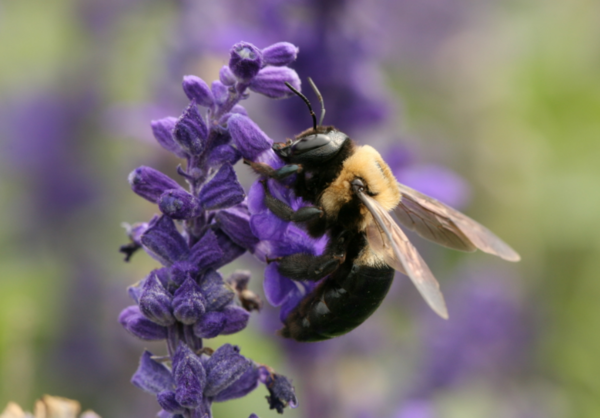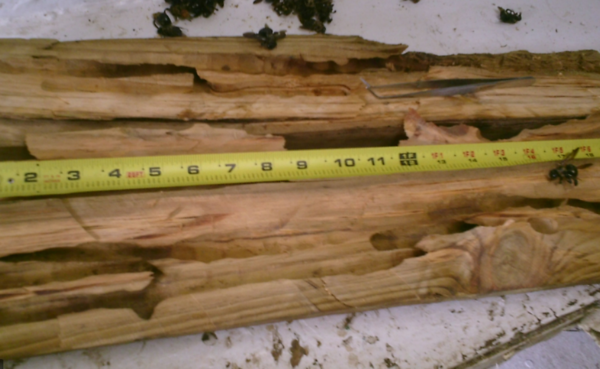
Carpenter bees bore extensive holes in your decks, pergolas, fences, sheds and eaves. Left untreated, a carpenter bee infestation can ruin your wooden structures and make them unsafe.
You can get rid of carpenter bees by spraying the area around their nests with insecticides. After you kill the bees or drive them away, there are many preventative measures you can take, like repairing damaged wood and treating it with insecticides, paint or essential oils that will deter the bees.
Carpenter bees live throughout the USA and cause problems for homeowners every year. This article will teach you all you need to get rid of carpenter bees and stop them from returning.
You might also be interested in reading these two related articles “How To Get Rid Of Hornets & Wasps” and “How To Get Rid of Yellow Jackets“.
Identifying Carpenter Bees
Carpenter bees are 1/2 to 1 inch long and look similar to bumblebees with yellow and black stripes. You can tell the difference between the two because carpenter bees have smooth, shiny abdomens, while bumblebees have hairy lower bodies.
You can often see carpenter bees in the spring flying around porch railings, near eaves and under decks. They are looking to make their nests inside the wood, but they don’t eat it. They feed on nectar and pollen from flowers.
Signs Of A Carpenter Bee Infestation
You can identify a carpenter bee infestation by the nest holes they bore into wood. They make holes about 1/2 inch in diameter that looks like they were made by a drill bit when fresh. Older nest holes have softer edges that have been worn down over time.
Carpenter bees prefer unfinished softwood and bore tunnels in seasoned hardwoods, softwoods and decaying woods. Look for frass under the hole, which looks like sawdust and is the shavings from making the hole. In addition, carpenter bees prefer the sunny side of a house, furthermore, you are more likely to see them there.
You might see the female entering or leaving the holes to go for pollen to feed her babies. Males fly around the hole, showing aggression to protect it, but they can’t sting. On the other hand, female carpenter bees can sting when provoked.
What Carpenter Bees Do To Wood

Carpenter bees ruin the structural integrity of wood with their tunnels. The female bores straight into the wood for a few inches and then makes a 90-degree turn to create a gallery for laying eggs. The tunnel network created by carpenter bees can be anywhere from 6 inches to four feet long.
The bees might shelter in their nests all winter and use them again the following season. The longer they stay in the same nest, the more they damage the wood. The presence of carpenter bees also attracts woodpeckers, who further damage the wood.
Meanwhile, carpenter bees are not as devastating to wood as termites. They use the bathroom outside of their tunnels, which subsequently is better for the wood. They also don’t bore very far in a season, and the wood can survive an infestation.
Eliminating An Active Infestation
The first step to getting rid of carpenter bees is injecting insecticidal foam into the nest holes. The foam comes in a spray can with a straw that you aim into the holes. The foam expands inside the holes, killing any bees and larvae.
Insecticides are dangerous for your health, so be sure to wear personal protective equipment like a respirator mask, eye protection, gloves and skin coverings. Likewise, keep children and pets away from the area where you were using the insecticidal foam.
The nests may have multiple entrances. Therefore, you should spray the foam until it comes out of another hole, or it will come back out of the hole you sprayed it into if there is no exit.
Plug The Carpenter Bee Holes
Once you have killed all the bees, you can stop any from returning by filling their holes. Plug the holes with one of several methods, including:
- Wood putty
- Caulking
- Wooden plugs
- Stainless steel screens
- Cork
Early fall is a safe time to fill the holes. You need to give the insecticide time to work. If you fill the holes before all the bees are dead, they might just make a new nest nearby.
Spray Insecticide Around The Infested Area
Spray an insecticide all around the bee holes and the surrounding wood. The wood should look wet if you have used enough insecticide. The spray will last as long as two or three months if it’s protected from rain. You may have to re-apply insecticide every two weeks.
Home Remedies For Getting Rid Of Carpenter Bees
Carpenter bees are important pollinators for flowers, fruits and forests. For this reason, you may not want to kill them. Or you might want to find a non-toxic solution to drive them away so that you don’t injure yourself, children or pets.
Luckily, there are several methods you can use to get rid of carpenter bees in an environmentally friendly way. Some are lethal methods, while some allow the bees to keep living and pollinating plants.
Use A Wire To Kill Carpenter Bees
You might be able to insert a stiff and flexible wire into a carpenter bee hole to kill the larvae. Firstly, you will need to observe the hole to see that the female has left. Be cautious because there could be more than one female sharing the same nest.
Next, insert the wire. It could be tricky to get it to bend around the first 90-degree turn. Finally, poke around inside the tunnel and try to break through the cells and kill the eggs and larvae.
Diatomaceous Earth Kills Carpenter Bees
Diatomaceous earth(DE) is made from fossilized algae. It works by drying out the exoskeletons of insects. It comes in a white powder that you can blow into the carpenter bee holes.
DE is not as harmful to the environment like other insecticides. You should still wear protective equipment while applying it because it can irritate your skin.
How To Get Rid Of Carpenter Bees With Vinegar
Vinegar is a household product that will kill carpenter bees. You can make a strong solution by mixing two parts vinegar with one part water. Spray the solution into the holes, making sure to completely saturate them.
The acids in the vinegar will cook the carpenter bee larvae. You may want to repeat the spraying several times to ensure you finish them off.
Vinegar might hurt your eyes or irritate your skin, but it’s pretty safe. After the bees are gone, you will need to take preventative measures so they won’t come back.
Play Loud Music
Carpenter bees don’t like loud noises or vibrations. Playing loud music at their nests could drive them out.
You might try placing a speak so that it faces and touches the wood around the carpenter bee nest. This would muffle the sound for you, but the bees might not like it. Unfortunately, you would probably need to play the music for at least 24 hours, and that might not be a sustainable solution.
Use A Carpenter Bee Trap
You can hang carpenter bee traps near holes or other places the bees might like to nest. Each trap has about a 15-foot radius of effectiveness. Traps are available from home improvement stores, or you can build one yourself.
Some people claim that the traps only catch male carpenter bees. Moreover, they wouldn’t stop the females from making holes and laying eggs.
More research is needed about carpenter bee traps, so you would be doing an experiment if you choose this route of getting rid of carpenter bees.
Traps may not be effective to get rid of carpenter bees on their own, but they are a good supplemental method. They also work for prevention and you should hang them every spring before the bees become active. Some carpenter bees that get trapped will die, but if any survive, take them far away from your house to release them so they can continue to pollinate.
How To Prevent Carpenter Bees
Stopping carpenter bees from making nests is the best way to protect your property from them. Most prevention should start at the end of winter before the bees become active.
Paint Wooden Surfaces
Painting or varnishing wood deters carpenter bees from boring into it. Be sure to paint the downward-facing surfaces where the bees prefer to make their nests.
Build With Treated Wood
Treated lumber is made to deter insects, including carpenter bees. There is still a chance the bees could bore into treated wood, but it’s much less likely than with untreated wood.
Spray Citrus Oil
One of the scents that carpenter bees hate is citrus. You can make a citrus spray by adding some essential oils to water or buy a premade one. Other essential oils that can repel carpenter ants include:
- Spearmint
- Peppermint
- Cinnamon
Spray an essential oil solution on wooden surfaces where carpenter bees could make a nest. Do it in the spring when they search for a place to live. You will have to re-apply the essential oil spray every few days.
Repair Damaged Wood
Any damaged wood is an appealing home to carpenter bees. Fill any holes, whether bee holes or not. Cracks or rotten spots also invite carpenter bees and should be repaired.
You might consider replacing any wood that has been damaged by carpenter bees. You never know how extensive the damage is. Replacing bee-damaged wood could save your structure and will deter the bees from returning.
Borate To Prevent Carpenter Bees
Borate wood treatments stop all insects from attacking wood. It works best in areas that are protected from the elements like covered decks. It is a low toxicity product so it is not as harsh as some insecticides.